The most sophisticated Tuono with a new Marelli ECU, combined with an all-new five-inch colour TFT dash, allows more innovative rider aids than ever. New looks, a higher revving V4, a new swing-arm, and a new aerodynamic package — it is the best Tuono to date. Having spent a day on track at Misano MotoGP racetrack in Italy, we came back highly impressed by this motorcycle. Here is how and why
You could say Aprilia have a slightly unfair advantage as they smartly fitted an Akrapovic silencer to the test bikes, to simply add to the amusement around Misano. It does sound amazing, even at tick-over. I know from experience that Aprilia’s V4 has always had a distinctive “character” but now, with more revolutions per minute (rpm) to play with (300 rpm more) this has amplified the experience to over-indulgent levels.
Leaving the famous pit-lane at Misano, the new Factory sounds magnificent, the V4 blasting pulsating vibrations off the pit wall. Out on to the track on pre-heated Pirelli slicks (no need to warm them up), the bike is straight into it, accelerating hard to join the swarm of Italian racers already up to race speed.
The noise is lovely, what a voice! This is escorted by the smoothest of quick-shifter changes I have experienced on a road bike. The changes are quick, perfectly matched in rpm; it is as if the peg, selector, and gearbox have been purposely designed for me.
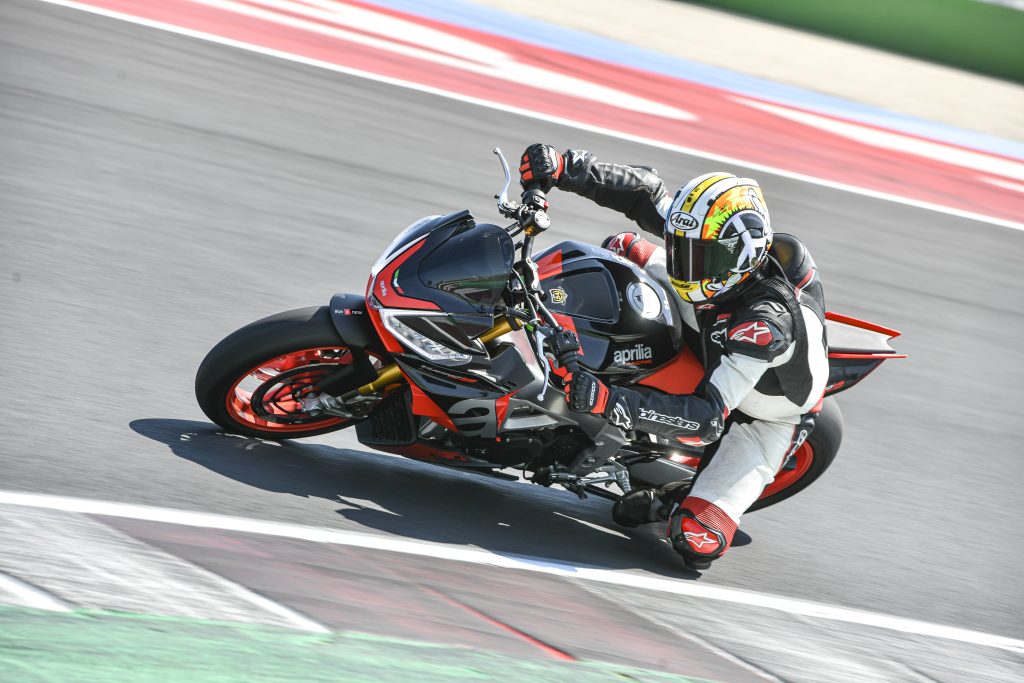
The fuelling and throttle response, like the clutchless gear-changes, are perfect. Aprilia have uprated the electronics with a new Magneti Marelli ECU, which is essentially the brain that controls the fueling and rider aids. This is four times faster than the previous ECU, which results in possibly one of the most precise, perfectly fuelled bikes I have ever ridden — even in Race mode (one of the six modes to choose from). Yes, our test bike was that good. I always applauded the old bike’s fuelling and electronic rider aids, especially the quick-shifter, which I did not think could be improved. But it has been.
Straight away, the new Tuono felt like my bike, one I had owned for years. The fuelling and up-and-down shifts instantly boost rider trust and that all-important connection between rider, bike, and road. I was pushing hard from lap two on a track on which I had not ridden since 2008.
The new Tuono may “only” have 175 hp, on paper considerably down on power as compared to the Italian competition from Ducati and MV, but that power is usable. Nothing goes to waste, meaning you can use every horsepower. Make no mistake: it is fast, accelerates hard, but it is not overwhelming and the rider aids (more about those later) are, like the fuelling, outstanding.
Aprilia’s anti-wheelie is picture-perfect, balancing the front wheel lift whilst still accelerating hard. I applaud the fact that the traction control can be changed on the move, even at 100 percent throttle. Unlike other naked bikes in this hotly contested category, that small aerodynamic top fairing, now with built-in winglets, offers some wind protection.
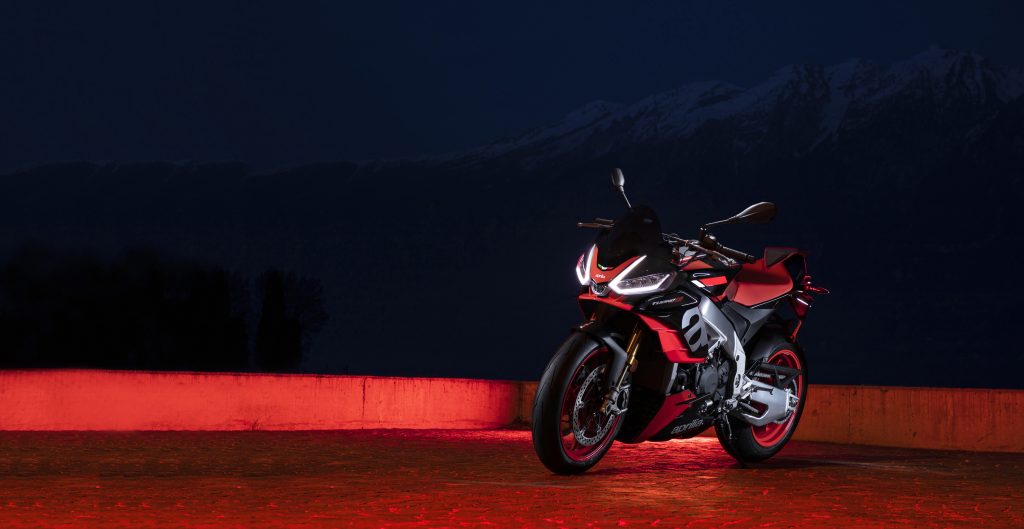
The combination of the fueling, rider aids, gearbox, power delivery, and the aero-package make the Factory ultra-usable on track and, relative to the competition, easy to ride, too; certainly, less physical than the competition. You do not have to be an expert to get the most out of the V4 Factory.
Yes, again Aprilia have bent the rules slightly by fitting Pirelli SC1 slicks (Pirelli Diablo Supercorsa are the standard fitment) and they chose the perfect setting for the very grippy Misano racetrack, could it get any better — but still the Tuono was mighty. You can change the Öhlins electronic suspension, compensate for the rider’s weight and conditions or even revert to the manual modes without semi-active assistance. But I stayed with the recommended A1 settings, which for my style and weight were faultless.
Nothing seems to unsettle or worry the new Tuono; it makes life easy. Brake late and you still hit the apex with perfect precision. Accelerate early and it continues to hold its line. The handling boosts confidence. Everything is controlled. You do not panic. It does not feel like you are rushing or in a fight; you have more time to choose your line and brake point. A bike with this much power and one that weighs 209 kilograms with a full tank of fuel should not be this easy to ride quickly, especially on a demanding track like Misano, but it is.
To be honest, the slicks and track’s MotoGP-spec surface meant grip was never an issue. The newly formed fuel-tank allows you to move around freely but still offers support. Ground clearance is not an issue, which is handy to lay the Tuono on its side like an obedient dog.
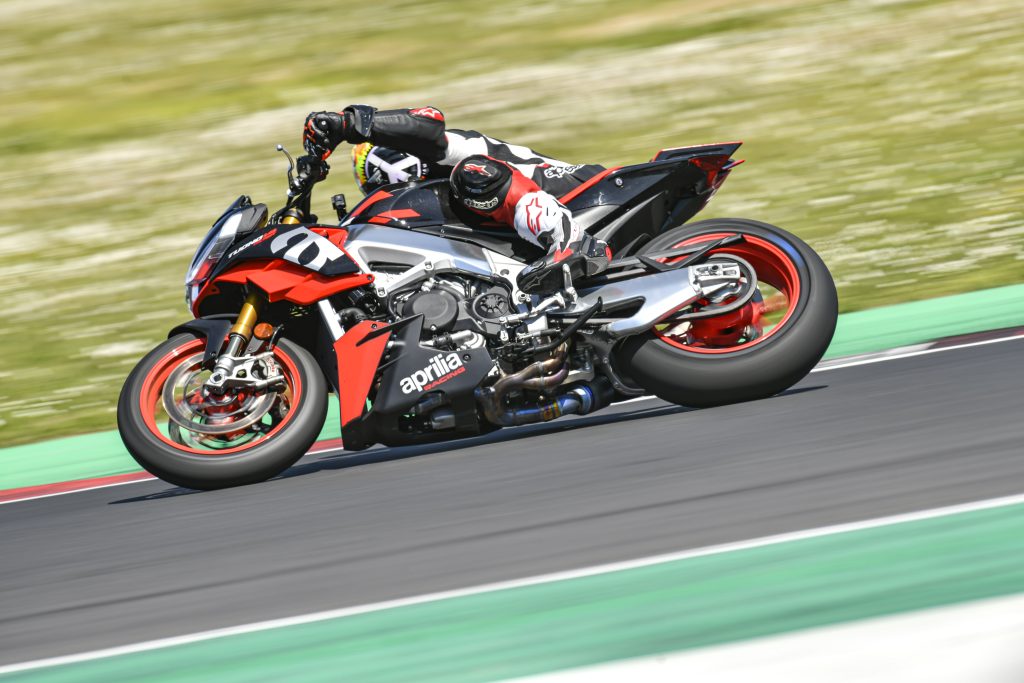
The new fairing — yes, a fairing on a naked bike, shall we argue later… — with built-in winglets is designed to enhance high-speed stability by boosting downforce. In the A1 set-up (automatic suspension), I had the very slightest of bar movement at the top of fifth gear, but it was virtually nothing. Sometimes electronic semi-active suspension can feel a little vague. But this was not the case with the new Tuono. The translation from the suspension and tyres was excellent.
Brakes remain the same M50 Brembo calipers found on the previous model. Three-level cornering ABS (co-designed with Bosch) allows ABS to be removed from the rear should you so wish. The system works in partnership with the Rear Liftup Mitigation (RLM), which prevents the rear wheel from rising during heavy braking.
Aprilia Engine Brake (AEB), which adjusts the engine brake control, is new for 2021 and is now independent of the selected engine maps. Now you can personalise and trim the engine braking “strategy”. AEB also takes lean angle and acceleration into consideration as you brake and roll into a turn, for example. Although the mechanical components of the brakes remain the same, the algorithms and calculations activating the system are quicker — the ABS is more alert. Essentially, you have a graduate from Oxford University making the calculations.
In the past, the Tuono has always scored highly, essentially because it is not a fully naked bike and the small top fairing goes a long way towards deflecting some of the windblast compared to the competition. It is the most bearable at speed. The fuel-tank has been reshaped, homologated capacity 17.9 litres, with a quoted 13.8 km/l. Sorry, but since this was a track-only test, we did not get a test figure. Practically speaking, cruise control comes as standard and the new and clear five-inch TFT dash is informative and easy to navigate. The three road-orientated riding modes — Tour, Sport, and User (a personalized mode) — change the power characteristics, rider aids, and the support and actuation of the semi-active suspension. And should you want something more “sensible”, do not forget the standard model (see box), which has conventional suspension and more road-focused ergonomics for both rider and pillion but with the same performance and new technology.
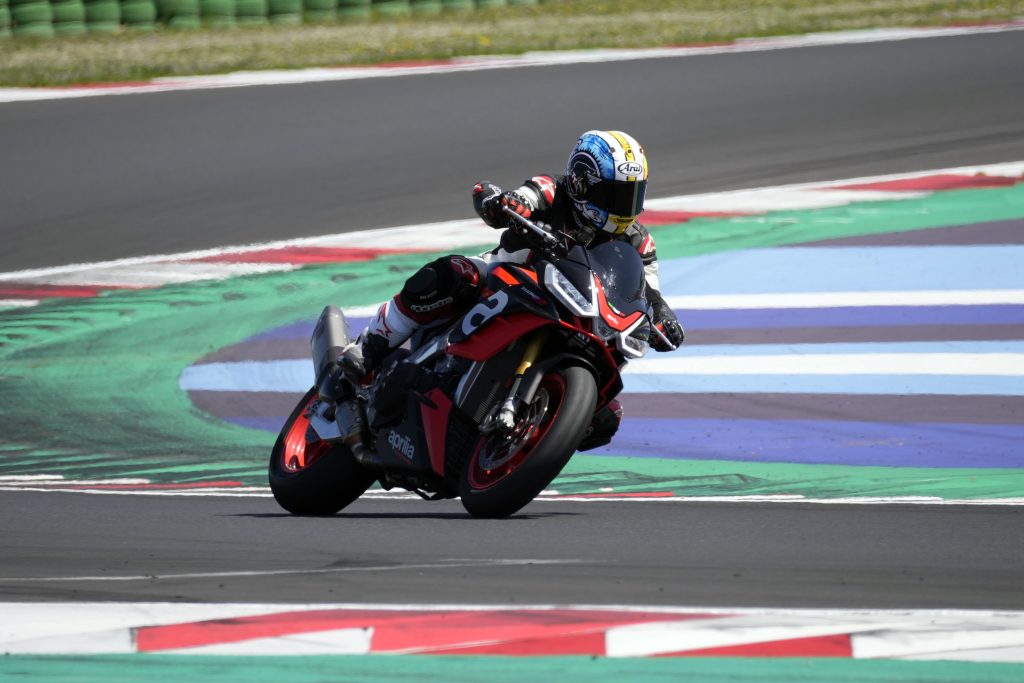
In the accessories list, there are also practical products available, such as a comfort seat, side panniers, a larger top fairing, USB port, and the MIA kit for Bluetooth connectivity. Aprilia have almost thought of everything. All the rider aids come as standard on the Factory, so you do not have to buy an additional accessory package. And the list is impressive. The Magneti Marelli ECU is key to the advanced rider aids as it is now able to operate four times faster than the previous ECU. This is linked to the six-axis IMU, which also takes information from various sensors around the bike such as brake pressure and wheel speed, to name but a few.
ATC (Aprilia Traction Control) has eight levels and can be changed on the move, even while accelerating. This is important and often overlooked. In one particular session, I had to leave pit-lane on a brand-new slick, so I increased the TC to six. Then, after one lap, whilst tucked in and accelerating down the main straight, I flicked it back to level three. On lap two, I performed the same action and, finally, flicked down to one. I did not have to move off-line, slow down, come on to the pits or look at the dash for more than a second. This is simple and easy to do, via the toggle finger-and-thumb switch on the left bar.
Additionally, there is AWC (Aprilia Wheelie Control), which has five levels and, like the TC, can be changed while on the gas, an added bonus that not only shaves lap-times but made the bike easier and more fun to ride. Again, if you feel intimidated at a track which undulates violently, you can add more wheelie control whilst still lapping at a reasonable rate.
There are three different engine maps (AEM), those three engine braking levels (AEB), and, as before, three settings for Aprilia Launch Control (ALC). Aprilia Pit Lane Limiter (APL) can be used as a pit-lane limiter or, on the road, to comply with specific speed limits. However, riding through a 50-km/h zone, bouncing off the pit-lane limiter, is not cool. Let us not forget, as mentioned, Aprilia Cruise Control (ACC) and the commendable Aprilia Quick Shift (AQS) have a new operating strategy for 2021 that even allows downshift with the throttle still open.
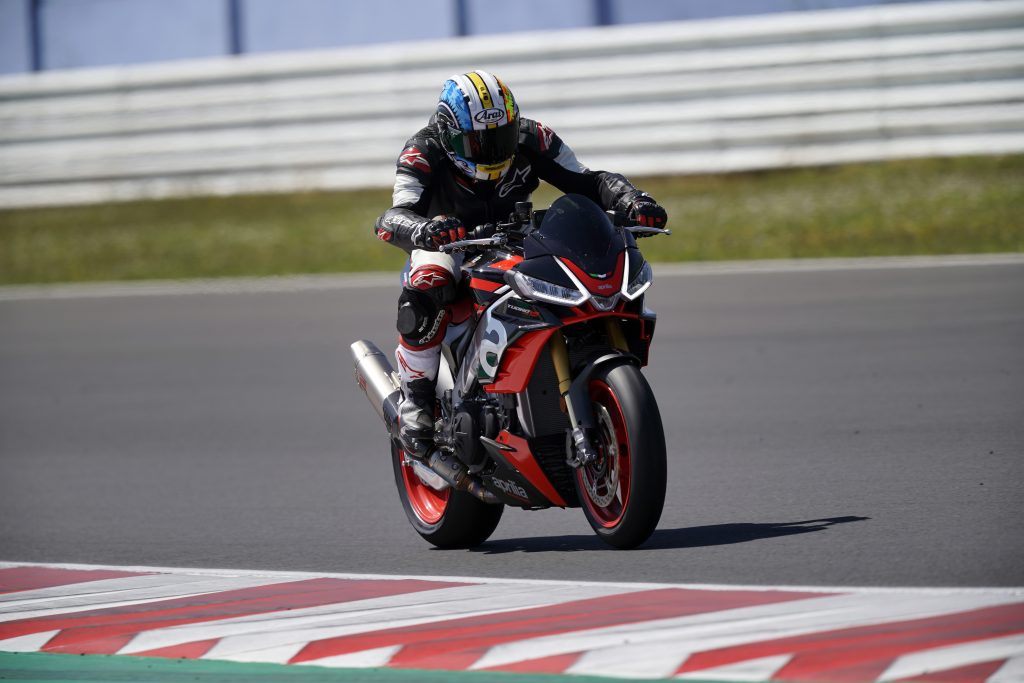
Add the cornering ABS trickery and that sums up a lengthy list of features and safety aids, all easily accessible via the new TFT dash and easy-to-use switchgear. The dash alone is a substantial step up over the previous bike, whose clocks were starting to appear a little dated next to the competition.
Aprilia have edged up to £18,100 (Rs 18.64 lakh) from £17,200 (Rs 17.72 lakh) in 2020. However, bearing in mind the new technology and upgrades, that is not bad and still below the competition with similar specifications.
Ducati’s V4 Streetfighter S uses similar Öhlins smart suspension, comparable rider aids, and is arguably just as desirable; maybe, more. But the Ducati is £20,000 (Rs 20.60 lakh), £2,000 (Rs 2.06 lakh) more than the Aprilia. But the extra money buys engine performance with another 30 hp over the V4 Factory on test.
MV have the stunning Brutale 1000RR, which also uses similar suspension, but this time prices start at £27,290 (Rs 28.11 lakh) (yes, you did read that correctly). Like the Ducati, the MV is also a member of the 200 hp-plus club. KTM’s 1290 Super Duke R and Triumph’s significantly updated Speed Triple 1200 RS are comparable in terms of on-paper performance and are cheaper (KTM £15,700 = Rs 16.17 lakh, Triumph £15,100 = Rs 15.55 lakh) but you have to get your hands dirty as they both come equipped with conventional suspension, not the very clever semi-active units on the Aprilia and Italian competition.
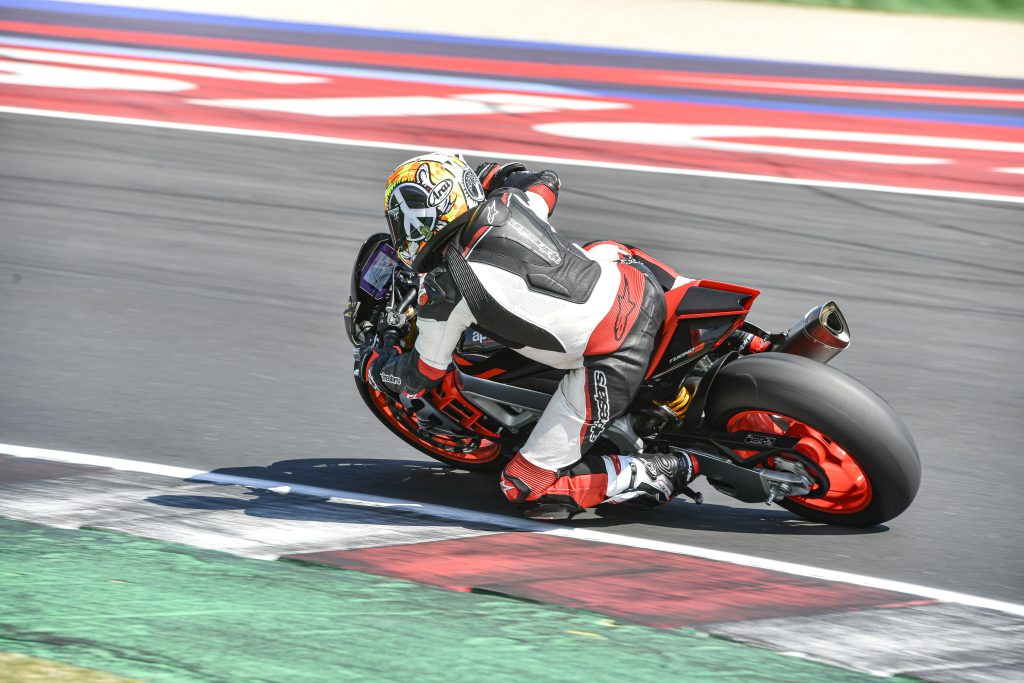
I have ridden the now “old” Tuono V4 Factory extensively in the past, both on the road and track. I have always celebrated its accessibility, electronics, and handling and, personally speaking, I did not think the bike could be significantly enhanced — but it has been. The rider aids, including the fuelling and quick-shift, are among the best I have ever experienced on a road bike. The new dash and switchgear make the rider aids all the more accessible.
The added over-rev is a nice touch and, while the V4 may not have figures comparable to other Italian super-naked bikes, all the power is usable, nothing is wasted, even for less experienced riders. The handling is excellent and the semi-active suspension takes none of the raw feeling away as some systems do. Oh, and did I fail to mention the looks — this motorcycle is a looker.
Undeniably, the test conditions were perfect: we were at Misano, on slicks — it does not get any better. And we did not get to ride on the road where most bikes will be ridden. But the old bike was a great road bike, arguably still is, and I see no reason why the new V4 Factory should not carry on this tradition.
For 2021, Aprilia have produced two quite different versions of their hyper-naked, the standard Tuono V4 and the Tuono V4 Factory, which we have on test (on track only) in Misano, Italy. The standard version is very much a break with habit; with a larger top fairing, higher bars, a comfier seat, grab handles even, lower pillion pegs, and a taller top gear, you could almost describe it as reasonable. It is focused on practicality and high mileage, which is not what we would expect of a Tuono. Engine performance is the same in both models, but the standard version comes suspended on manual, fully adjustable suspension, rather than the arguably more desirable, track-focused Factory version with Öhlins Smart EC 2.0 semi-active suspension. The bodywork gets reduced in size and, for 2021, gets built-in winglets while the ergonomics are more directed to sporty track riding. It is a big step for Aprilia to produce two very different models using the same platform.


Leave a Reply